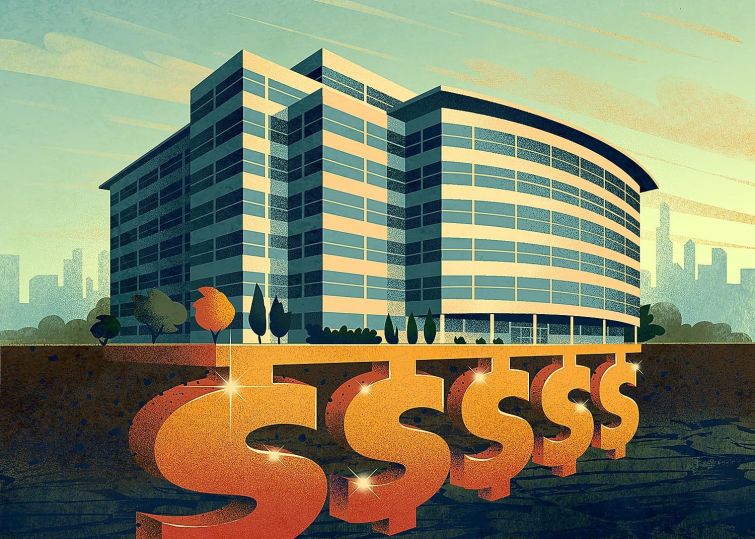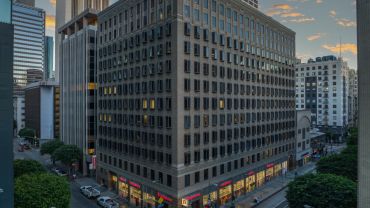The Modern Ground Lease’s Proliferation Amid COVID-19
COVID-19 has helped the proliferation of the modern ground lease space and pushed more players into the arena in search of stable, predictable cash flows
By Mack Burke March 16, 2021 3:09 pm
reprints
In early 2019, Safehold (SAFE) did not have a single ground lease in New York’s five boroughs.
It’s since expanded rapidly, and, now, about 40 percent of its portfolio of around 75 ground leases, which reached $3.2 billion in value in the fourth quarter, are located in the Northeast.
Since its initial public offering in 2017, the publicly traded real estate investment trust (REIT) has mounted a campaign to change the way the commercial property sector works, separating physical real estate structures, and the dirt on which they stand, into two separate investments in a bid to help further line the pockets of building owners, and create more stability and predictability for every party involved in a real estate transaction.
Safehold’s mission began with education. The company needed to teach the industry about the long-term benefits of a modern, consumer-friendly and flexible, ground lease structure that would limit equity requirements, reduce the cost of capital and — in turn — increase returns and asset values for owners and developers (as well as inject a level of transparency and calculability for lenders).
Up until the last several months, Safehold has been lonely. It quickly became the most recognizable institutional player in the modern ground lease space, but it lacked true competitors, much to the disappointment of its Chairman and CEO, Jay Sugarman.
“We are delighted if it continues to grow,” Sugarman said of the ground lease space. “We think we have a four-year head start on everybody. We want everybody who owns or deals in real estate to put the old-fashioned ground leases behind them and take a fresh look.”
The economic realities of COVID-19 have helped capture the attention of the broader market. And Sugarman, as well as other industry veterans who spoke to Commercial Observer, could not be happier about the revolution that’s been sparked.
The ground lease revolution in New York, specifically, has been underway for some time now, with city development staples like the Kaufman Organization making it a key component of its business, first in Midtown South.
Related Companies has a small, ground lease-focused operation that flies under the radar, and other firms, like Miami-based Kawa Capital Management and New York-based real estate investment banking firm Eyzenberg & Co., have been proponents of different models of the modern ground lease.
But, in 2020, the space welcomed a couple of new fleet-footed players to the dance floor.
Behemoth investment manager Ares Management (ARES) Corp. and London-based global investor Regis Group joined forces amid the pandemic to launch Haven Capital, a private, ground lease investment vehicle, before the end of the year. And Dallas-based real estate investment firm Montgomery Street Partners announced in early February that it partnered with a “U.S.-based Fortune 500 insurance company” to launch a private REIT called GLR (short for Ground Lease REIT).
Interestingly enough, both Haven and GLR came out of the gates armed with $1 billion in capital to deploy in the U.S.’s top 50 metropolitan areas across every asset class. It’s quite a head start in an attempt to catch up with Safehold, which holds ground in every region of the country — mostly under office product — and went into 2021 with $700 million in purchasing power, and a credit revolver that was upsized and sits at $600 million.
“We think that, particularly in a time where it’s tough to find financing in many sectors, this is an attractive source of unlocking value for an underlying owner,” David Roth, a partner at Ares Management, told CO last fall. “It’s a sale of a part of the cash flow at a higher price than what you’d get on the open market. Depending on the value of the leasehold position, you can actually increase the value of the total cash flow stream.”
Not long after Haven launched last November, one source told CO that Safehold’s legwork in popularizing the modern ground lease has likely opened the floodgates, and that it’s only a matter of time until the space becomes crowded.
Roth said it’s all similar to when commercial mortgage-backed securities (CMBS) came around and buyers of different risk profiles were then able to price different parts of the cash flow stream. It just so happens that the pool of buyers is now starting to fill up.
Sugarman said that the possibilities for the modern ground lease space are next to unlimited — at least, for now — within what he’s said is a $7 trillion commercial real estate market. Opportunities abound, and for Sugarman, and even Eyzenberg & Co. President David Eyzenberg, it will only help to spread the modern ground lease gospel.
“If you go back just four years, nobody thought of ground leases as we’re seeing them described, as an efficient capital tool to take the operating business and the fixed asset, and sell them to the highest bidders,” Sugarman said. “When we created it, we wanted to make it mainstream.”
“We’re seeing more adoption and more repeat business, and more application to parts of the commercial real estate world,” Sugarman added. “[Four years ago], we had this eureka idea of building a better mousetrap for customers, giving investors a chance to, for the first time, really be able to invest in this asset class that has been around for a long time and has made great fortunes for people, but had never really been created with the customer in mind.”
Safehold helped established the logic of the modern ground lease, tying together “the parallels to what net lease has done for the corporate world,” where it’s enabled capital to be more efficient in choosing to invest in the operating business, while another entity invests in the fixed asset, which the industry has seen with cell towers or casinos.
Traditionally, the ground lease allows an owner of land to lease out the ground to an operator under a long-term agreement — typically 99 years — to construct or manage a piece of real estate on the premises. Over the last few decades, it developed a bad reputation, as many real estate partnerships on high-profile assets in New York, like the Chrysler Building, the Lipstick Building and Lever House, went south, due to inherent, structural issues with the lease that were bound to materialize.
“This is ground lease 2.0,” Roth said. “Ground lease 1.0 had bespoke provisions and every deal was different; and those ground leases had fair market value resets.”
The issues centered around things like a lack of flexibility and uneconomical costs from unreasonably structured, legacy ground leases on those properties. Older ground leases — or the “ground lease 1.0” space — were improperly sized to the value of the property and didn’t exhibit a predictable cash flow stream, due to fair market value rent resets, which, in some cases, would prove costly because of their typical, century-long lease terms.
“The modern ground lease is more about capital structure,” Eyzenberg said. “In the old days, people were playing a zero-sum game; one group was trying to make returns. Ground lease investors should try to make a fixed income. There should be a low-yield, benign owner of the leasehold ground lease and an entrepreneur above them.”
“I took my inspiration from the CMBS market, in the sense that it worked, because they created a doorway for the [AAA] fixed-income universe to come in,” Eyzenberg added.
Ground rent for a real estate operator should be “more predictable than taxes and utilities,” Sugarman said.
It’s something that a real estate operator shouldn’t have to think about, a worry of whether the value of the structural real estate will be destroyed, due to poorly timed and structured rent triggers within the lease. Essentially, the land shouldn’t be an impediment. Safehold’s methodical approach would put the REIT out of sight and out of mind when it comes to its ground lease investments.
Sugarman said that the logic around “ground lease 2.0″ had never brought to the forefront in a way the industry could understand it. “”The whole industry had sort of missed that opportunity,” Sugarman said. “We created the nomenclature, the framework … [It allows real estate owners] to use their skill set — building, managing, leasing and designing buildings, the operating business — and not have to take their precious, high-return capital and invest a big chunk of it into land, which is essentially a long-term bond; it’s very passive.”
The passiveness of the modern ground lease means it won’t be for everyone.
Eyzenberg, whose firm has worked in conjunction with Safehold on a number of deals, said that it’s about “creating a modern ground lease to make it financeable and accretive to the leasehold position. It should be a long-term, fixed, AAA-type instrument and accretive to the capital stack. If not, you see leasehold destruction, because of higher rent escalations and higher prices.”
A more “financeable” ground lease is key, structurally. Sugarman said lenders “hate uncertainty and ambiguity. If you tell me I have to decide what something’s going to look like, I’m going to pick the worst possible scenario. When you have a fair market value reset, I have no idea what your future rent is going to be in the event of XYZ happening. We want lenders to look at this, and say, ‘I can do what I do well, which is properly size a first mortgage on the building.'”
Kawa Capital Management, an investment firm launched 15 years ago that has executed on 23 ground lease transactions worth nearly $1 billion, just recently acquired 16 acres under a seven-story, 434-key hotel located in Orlando.
“We see [the ground lease space] as the next foray of opportunity in commercial real estate, especially in the U.S.,” said Jacques Holzmann, a Director at Kawa, who spearheads its ground lease practice. “The ground is really a way for sponsors who own buildings or are trying to acquire buildings to get long-term, cost-efficient capital into their developments and existing properties.”
“We see ground having a lot of value in the ‘unloved’ sectors,” Holzmann added. “Where it really adds value to the sponsor is if you have a fee simple property that trades somewhat wide in the spectrum where things trade today — retail, hotel and suburban office, you know, things that trade in the 8 to 12 caps [range]. When you put ground on something like that, as long as they are properly sized, the ground spread doesn’t move all that much. If you’re looking at an 8 cap property, as soon as you introduce a 4 cap ground, the leasehold becomes a 12 cap, so it’s pretty powerful for these kinds of properties.”
Holzmann said everything changes in the “more loved sectors,” like multifamily, where the benefits of the ground lease aren’t “as apparent.”
“You’ve got to find the right sponsor and the ground has to be sized properly. It’s not about ground proceeds, it’s about how the ground interplays with the leasehold lender, making sure that you’re not extracting too much value from the leasehold, so that the sponsor still has the ability to exit and make money, as well as put accretive capital into the leasehold from a financing standpoint,” Holzmann added.
COVID-19 and the uncertainty that still exists in the market has made the prospect of ground lease investment a less-drab endeavor. It helps that investor efficacy for Safehold has served as an indication of the proliferation of the new guard.
Despite extreme volatility in the equity markets last year, Safehold has seen its stock jump nearly 84 percent — now priced at $76.42 as of today — year over year from March 16 last year, around when COVID-19 first gripped the economy, the stock market and real estate sector. Its portfolio has ballooned to $3.2 billion from just $300 million, when it IPO’d in June 2017, and it was listed as Nareit’s No. 1 performing REIT stock last year, reeling in a total shareholder return of 82 percent. To cap it off, it secured an investment-grade credit profile last month from both Fitch Ratings and Moody’s Investors Service.
“2.0 is much more user friendly,” Ares’ Roth said. “The cash flow stream is much more predictable. There are no fair market value resets. But you may have [a Consumer Price Index] lookback not based on fair market value.”
A consumer price index (CPI) reset, or “lookback,” is a main way in which rents are being established in modern leases — combined with fixed annual escalations — and it’s also a way in which the lessor can be protected from inflationary pressures. Should the CPI climb over time and the property lose value, rent increases would be calculated based on the change in the CPI.
It’s a rent reset that isn’t nearly as aggressive and unpredictable as a fair market value reset, and it’s also a way in which modern ground lease investors differentiate themselves. Another avenue is a buyback option for real estate owners that sell their control of the land to one of these investors.
Safehold’s institutional model currently lacks a clear-cut buyback option and is one way in which new entrants can gain ground on the REIT, sources said, although Sugarman told CO his company has “a number of innovations on the shelf. We can pretty much do anything that we think our customers need and want.”
“With a properly sized, properly priced, and properly structured ground lease, you shouldn’t ever have to buy it out,” Sugarman said. “If you want to pay a premium for an option in the future you don’t need that will cost you a lot of money, have at it. We don’t think that serves the customer.”
Haven Capital came out of the gates offering a buyback option with different pricing mechanisms that it believes can help set it apart. “Many owners of real estate don’t want to sell the underlying real estate forever,” Roth said, alluding to certain landowners, such as small families, who hold land as an income producer for generations and aren’t keen to let it go.
The overarching mission of the modern ground lease is to fit it comfortably within the capital stack, and to unlock additional value for owners and operators to then focus on maximizing the value of the real estate without the need to worry about any surprises.
“We studied for almost a year every ground lease we could find in this country and others to see what the flaws are,” Sugarman said, pointing to the Lipstick Building in New York as an example of a lease gone wrong that led to unwelcome surprises for the parties involved. A $272 million CMBS loan backed by the ground under Ceruzzi Properties’ Lipstick Building at 885 Third Avenue hit special servicing last summer, because the Metropolitan Real Estate investors and IRSA, an Argentinian real estate developer, defaulted on an inflated ground rent in May amid the pandemic. Ceruzzi, along with SL Green Realty Corp., then had to scramble to resolve the situation.
“Lipstick, in particular, is improperly sized,” Sugarman said, adding that a ground lease likely shouldn’t eclipse 35 percent of value. “That ground lease was almost the entire value of the building. That is a mistake. That is not a ground lease that’s disguised equity. It was improperly structured, with multiple parties involved. The rules of the road need to be really simple and clear for the lending markets and future buying markets to be efficient. That one is anything but simple and clear.”
He added that these are straightforward rules that exist in the finance and net lease worlds, and just need to be applied to the ground lease world to create a simple logic to showcase more capital and cost efficiency, as well as less risk.
“To run these large, institutional-quality buildings, that is a unique skill set and one they should be paid well for,” Sugarman said. “Why are they taking their capital and putting it in a long-term bond? It doesn’t make sense.”
“When you look at these one-off, unfortunately, value-destroying, ground leases from the past, they really come about when the customer says, ‘How much money can I get from the ground?’ That is completely the wrong question,” Sugarman added. “The right question is, ‘How do I optimize my capital structure?'”
That in, and of, itself is Safehold’s mission in developing a business around this product, to do away with the “one-off” ground lease and try to eliminate any peculiarities that might exist inherently from one deal to the next, in an attempt to make it more digestible and repeatable.
“We think that there’s an awful lot of real estate where value can be unlocked by using this [method],” Roth said.
“The flip side of it, and the reason we’re doing it, is if you put a pool of this stuff together, based on a belief we’re in a lower-for-longer environment, it will produce very safe, cash flow streams,” Roth added. “It’s all about the execution, taking what I would call non-institutional ideas and taking them to scale to create institutional platforms. The timing is pretty perfect, or proactive in the sense that we’re not the first to do this.”
Until several years ago, the modern ground lease was a misfit toy, one that only a handful of aficionados saw as the future of the commercial property sector. COVID-19 only sparked an acceleration in the number of bets on its safety and predictability.


